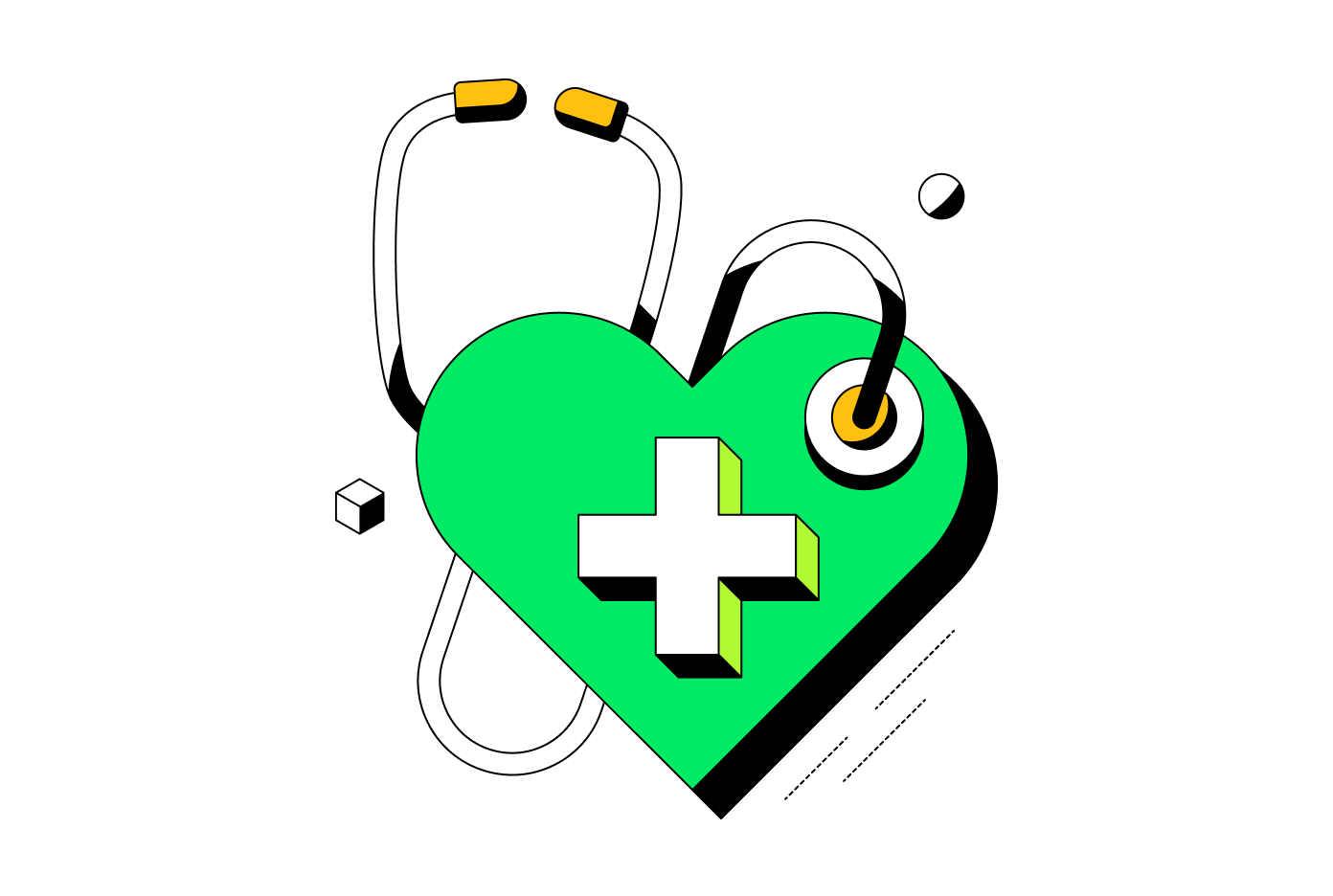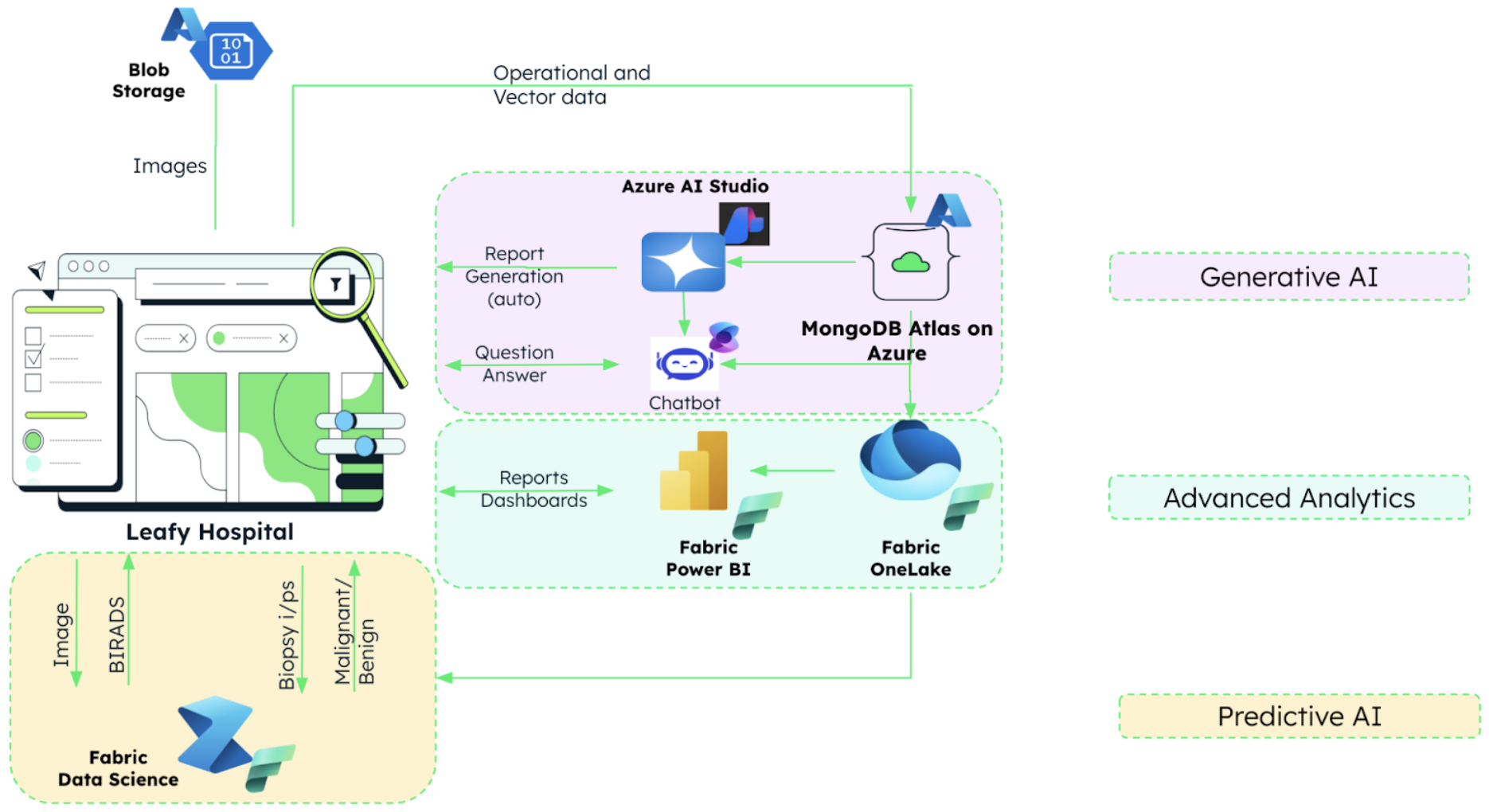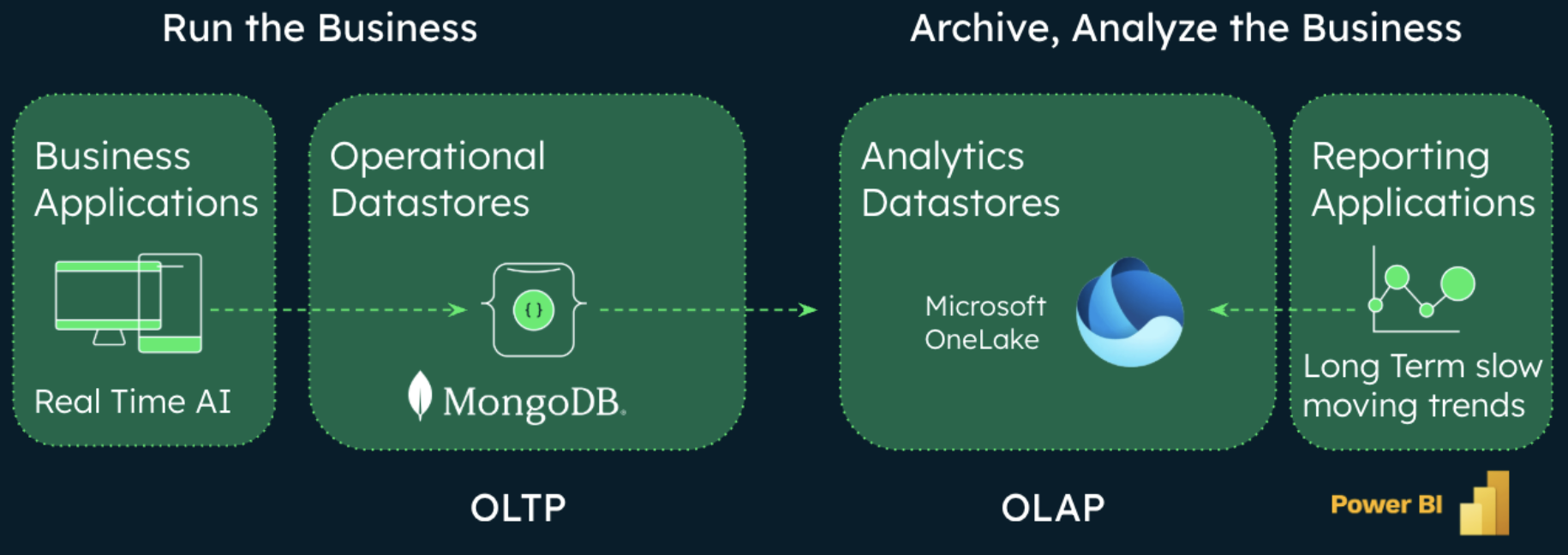Healthcare is on the cusp of a revolution powered by data and AI. Microsoft, with innovations like Azure OpenAI, Microsoft Fabric, and Power BI, has become a leading force in this transformation. MongoDB Atlas complements these advancements with a flexible and scalable platform for unifying operational, metadata, and AI data, enabling seamless integration into healthcare workflows.
By combining these technologies, healthcare providers can enhance diagnostics, streamline operations, and deliver exceptional patient care. In this blog post, we explore how MongoDB and Microsoft AI technologies converge to create cutting-edge healthcare solutions through our “Leafy Hospital” demo—a showcase of possibilities in breast cancer diagnosis.

The healthcare data challenge
The healthcare industry faces unique challenges in managing and utilizing massive datasets. From mammograms and biopsy images to patient histories and medical literature, making sense of this data is often time-intensive and error-prone. Radiologists, for instance, must analyze vast amounts of information to deliver accurate diagnoses, while ensuring sensitive patient data is handled securely.
MongoDB Atlas addresses these challenges by providing a unified view of disparate data sources, offering scalability, flexibility, and advanced features like Search and Vector search. When paired with Microsoft AI technologies, the potential to revolutionize healthcare workflows becomes limitless.
The leafy hospital solution: A unified ecosystem
Our example integrated solution, Leafy Hospital, showcases the transformative potential of MongoDB Atlas and Microsoft AI capabilities in healthcare. Focused on breast cancer diagnostics, this demo explores how the integration of MongoDB’s flexible data platform with Microsoft’s cutting-edge features—such as Azure OpenAI, Microsoft Fabric, and Power BI—can revolutionize patient care and streamline healthcare workflows.
The solution takes a three-pronged approach to improve breast cancer diagnosis and patient care:
-
Predictive AI for early detection
-
Generative AI for workflow automation
-
Advanced BI and analytics for actionable insights

If you’re interested in discovering how this solution could be applied to your organization’s unique needs, we invite you to connect with your MongoDB account representative. We’d be delighted to provide a personalized demonstration of the Leafy Hospital solution and collaborate on tailoring it for your specific use case.
Key capabilities
Predictive AI for early detection
Accurate diagnosis is critical in breast cancer care. Traditional methods rely heavily on radiologists manually analyzing mammograms and biopsies, increasing the risk of errors. Predictive AI transforms this process by automating data analysis and improving accuracy.
BI-RADS prediction
BI-RADS (Breast Imaging-Reporting and Data System) is a standardized classification for mammogram findings, ranging from 0 (incomplete) to 6 (malignant). To predict BI-RADS scores, deep learning models like VGG16 and EfficientNetV2L are trained on mammogram images dataset. Fabric Data Science simplifies the training and experimentation process by enabling:
-
Direct data uploads to OneLake for model training
-
Easy comparison of multiple ML experiments and metrics
-
Auto-logging of parameters with MLflow for lifecycle management
These models are trained on a significant number of epochs until a reliable accuracy is achieved, offering reliable predictions for radiologists.
Biopsy classification
In the case of biopsy analysis, classification models such as the random forest classifier are trained on biopsy features like cell size, shape uniformity, and mitoses counts. Classification models attain high accuracy when trained on scalar data, making it highly effective for classifying cancers as malignant or benign.
Data ingestion, training, and prediction cycles are well managed using Fabric Data Science and the MongoDB Spark Connector, ensuring a seamless flow of metadata and results between Azure and MongoDB Atlas.
Generative AI for workflow automation
Radiologists often spend hours documenting findings, which could be better spent analyzing cases. Generative AI streamlines this process by automating report generation and enabling intelligent chatbot interactions.
Vector search: The foundation of semantic understanding
At the heart of these innovations lies MongoDB Atlas Vector Search, which revolutionizes how medical data is stored, accessed, and analyzed. By leveraging Azure OpenAI’s embedding models, clinical notes and other unstructured data are transformed into vector embeddings—mathematical representations that capture the meaning of the text in a high-dimensional space.
Similarity search is a key use case, enabling radiologists to query the system with natural language prompts like “Show me cases where additional tests were recommended.” The system interprets the intent behind the question, retrieves relevant documents, and delivers precise, context-aware results. This ensures that radiologists can quickly access information without sifting through irrelevant data.
Beyond similarity search, vector search facilitates the development of RAG architectures, which combine semantic understanding with external contextual data. This architecture allows for the creation of advanced features like automated report generation and intelligent chatbots, which further streamline decision-making and enhance productivity.
Automated report generation
Once a mammogram or biopsy is analyzed, Azure OpenAI’sLarge Language models can be used to generate detailed clinical notes, including:
-
Findings: Key observations from the analysis
-
Conclusions: Diagnoses and suggested next steps
-
Standardized codes: Using SNOMED terms for consistency
This automation enhances productivity by allowing radiologists to focus on verification rather than manual documentation.
Chatbots with retrieval-augmented generation
Chatbots can be another approach to support radiologists, when they need quick access to historical patient data or medical research. Traditional methods can be inefficient, particularly when dealing with older records or specialized cases.
Our retrieval-augmented generation-based chatbot, powered by Azure OpenAI, Semantic Kernel, and MongoDB Atlas, provides:
-
Patient-specific insights: Querying MongoDB for 10 years of patient history, summarized and provided as context to the chatbot
-
Medical literature searches: Using vector search to retrieve relevant documents from indexed journals and studies
-
Secure responses: Ensuring all answers are grounded in validated patient data and research
The chatbot improves decision-making and enhances the user experience by delivering accurate, context-aware responses in real-time.
Advanced BI and analytics for actionable insights
In healthcare, data is only as valuable as the insights it provides. MongoDB Atlas bridges real-time transactional analytics and long-term data analysis, empowering healthcare providers with tools for informed decision-making at every stage.
Transactional analytics
Transactional, or in-app, analytics deliver insights directly within applications. For example, MongoDB Atlas enables radiologists to instantly access historical BI-RADS scores and correlate them with new findings, streamlining the diagnostic process. This ensures decisions are based on accurate, real-time data.
Advanced clinical decision support (CDS) systems benefit from integrating predictive analytics into workflows. For instance, biopsy results stored in MongoDB are enriched with machine learning predictions generated in Microsoft Fabric, helping radiologists make faster, more precise decisions.
Long-term analytics
While transactional analytics focus on operational efficiency, long-term analytics enable healthcare providers to step back and evaluate broader trends. MongoDB Atlas, integrated with Microsoft Power BI and Fabric, facilitates this critical analysis of historical data. For instance, patient cohort studies become more insightful when powered by a unified dataset that combines MongoDB Atlas’ operational data with historical trends stored in Microsoft OneLake.
Long-term analytics also shine in operational efficiency assessments. By integrating MongoDB Atlas data with Power BI, hospitals can create dashboards that track key performance indicators such as average time to diagnosis, wait times for imaging, and treatment start times. These insights help identify bottlenecks, streamline processes, and ultimately improve the patient experience. Furthermore, historical data stored in OneLake can be combined with MongoDB’s real-time data to train machine learning models, enhancing future predictive analytics.
OLTP vs OLAP
This unified approach is exemplified by the distinction between OLTP and OLAP workloads. On the OLTP side, MongoDB Atlas handles real-time data processing, supporting immediate tasks like alerting radiologists to anomalies. On the OLAP side, data stored in Microsoft OneLake supports long-term analysis, enabling hospitals to identify trends, evaluate efficiency, and train advanced AI models. This dual capability allows healthcare providers to “run the business” through operational insights and “analyze the business” by uncovering long-term patterns.

MongoDB’s Atlas SQL Connector plays a crucial role in bridging these two worlds. By converting MongoDB’s flexible document model into a relational format, it allows tools like Power BI to work seamlessly with MongoDB data.
Next steps
To learn more about how MongoDB can power healthcare solutions, visit our solutions page.
Check out our Atlas Vector Search Quick Start guide to get started with MongoDB Atlas Vector Search today.
Source: Read More



